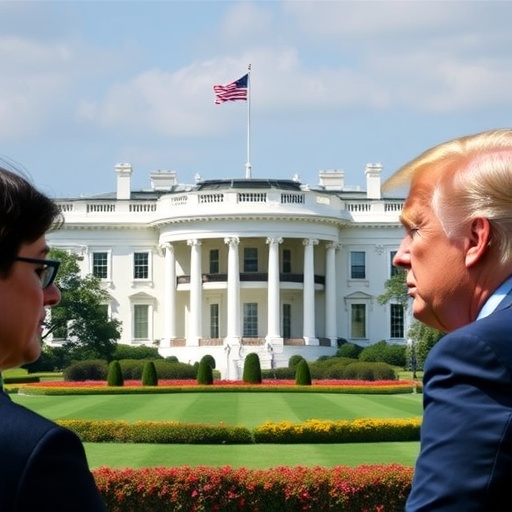Top U.S. Universities Reject Trump Administration’s Federal Funding Offer Over Academic Independence Fears
In a bold stand against potential government overreach, several prominent U.S. Universities, including the University of Arizona and Brown University, have publicly rejected a controversial funding compact proposed by the Trump administration. This decision, announced late last week, underscores deep policy concerns about preserving academic independence amid promises of boosted federal funding. The move has ignited debates across higher education circles, highlighting the tension between financial incentives and institutional autonomy under the Trump administration.
- University of Arizona and Brown Lead the Charge Against Funding Strings
- Unpacking the Controversial Terms of the Funding Compact
- Wider Ripples: How Rejections Are Shaking Up Higher Education Funding Landscape
- Expert Insights and Historical Echoes in the Funding Battle
- Looking Ahead: Negotiations, Lawsuits, and the Fight for Educational Autonomy
The compact, dubbed the “Higher Education Partnership Initiative,” offered Universities up to 20% more in federal grants and research dollars in exchange for aligning curricula and research priorities with White House objectives, such as emphasizing vocational training in manufacturing and energy sectors while de-emphasizing certain social sciences deemed “divisive.” University leaders argue that accepting such terms could erode the foundational principles of free inquiry that define American higher education.
This rejection comes at a precarious time for universities, many of which are grappling with rising tuition costs, declining state support, and the lingering effects of the COVID-19 pandemic on enrollment and budgets. According to the American Council on Education, federal funding accounts for approximately 10-15% of operating budgets at public research institutions, making the offer tantalizing yet fraught with risks.
University of Arizona and Brown Lead the Charge Against Funding Strings
The University of Arizona, a flagship public institution in Tucson known for its cutting-edge research in optics and astronomy, was among the first to formally decline the compact. President Robert C. Robbins issued a statement emphasizing the university’s commitment to unfettered academic exploration. “We cannot trade our intellectual freedom for short-term financial gains,” Robbins said in an email to faculty and students. “The Trump administration‘s proposal, while generous on paper, imposes ideological constraints that threaten the very essence of what makes our universities engines of innovation and progress.”
Brown University, an Ivy League powerhouse in Providence, Rhode Island, followed suit with even stronger rhetoric. Provost Francis J. Doyle III described the offer as “a Trojan horse for political interference.” In a campus-wide address, Doyle highlighted how the compact’s requirements could limit faculty hiring in fields like climate science and ethnic studies, areas that have faced scrutiny from conservative policymakers. Brown’s decision was particularly poignant given its recent investments in interdisciplinary programs addressing social justice and environmental policy—priorities that might clash with the administration’s agenda.
These rejections weren’t isolated; at least a dozen other institutions, including the University of California system and Stanford University, have signaled similar reservations. A joint letter from the Association of American Universities (AAU), representing 65 leading research universities, warned that the compact could “undermine the merit-based allocation of federal funding,” potentially stifling breakthroughs in medicine, technology, and humanities.
Behind the scenes, negotiations were tense. Sources familiar with the discussions revealed that administration officials, led by the Department of Education under Secretary Betsy DeVos, presented the compact as a “win-win” during virtual meetings in early October. However, university negotiators pushed back, citing policy concerns over clauses that required annual reports on “alignment metrics,” including student outcomes tied to administration-favored industries like fossil fuels and defense contracting.
Unpacking the Controversial Terms of the Funding Compact
At its core, the “Higher Education Partnership Initiative” promised an influx of $5 billion in additional federal funding over five years, targeted at STEM and vocational programs. Proponents within the Trump administration argued it would address the skills gap in the American workforce, aligning education with economic nationalism. For instance, the compact allocated funds for apprenticeships in manufacturing hubs and research grants prioritizing “America First” technologies, such as advanced border security systems.
Yet, the fine print raised red flags. Universities accepting the deal would need to integrate White House-vetted curricula into at least 30% of undergraduate programs, with oversight from a new federal advisory board. Critics, including the American Association of University Professors (AAUP), labeled this as “soft censorship,” pointing to similar past attempts during the McCarthy era to purge “subversive” ideas from campuses.
Statistics underscore the stakes: In fiscal year 2020, federal research grants to universities totaled $40.5 billion, fueling 70% of basic science discoveries, per the National Science Foundation. Rejecting the compact means forgoing potential boosts, but leaders like Robbins argue the cost to academic independence is too high. “We’re not anti-funding; we’re pro-freedom,” he clarified in an interview with NPR.
Moreover, the proposal included performance-based incentives, where funding could be clawed back if institutions failed to meet enrollment targets in specified fields. This carrot-and-stick approach echoed policy concerns from earlier Trump-era initiatives, like the 2019 executive order tying accreditation to free speech metrics, which some universities viewed as a ploy to favor conservative viewpoints.
- Key Compact Provisions: 20% funding increase for compliant programs; mandatory alignment with national security and economic priorities; annual compliance audits by federal reviewers.
- Potential Benefits: Expanded labs, scholarships for 50,000 students in high-demand trades.
- Risks Highlighted: Loss of tenure protections for non-compliant faculty; skewed research toward politically motivated outcomes.
Legal experts, such as Harvard Law professor Laurence Tribe, have weighed in, calling the compact “constitutionally suspect” under the First Amendment, as it could compel speech and viewpoint discrimination.
Wider Ripples: How Rejections Are Shaking Up Higher Education Funding Landscape
The wave of rejections has broader implications for the national conversation on federal funding and universities. Smaller liberal arts colleges, already strained by endowment shortfalls, are watching closely. For example, Oberlin College in Ohio, which relies on federal aid for 25% of its budget, has formed a task force to evaluate similar offers without compromising its progressive ethos.
Economically, the decision could exacerbate funding disparities. Public universities in red states, like Texas A&M, have shown tentative interest in modified versions of the compact, potentially creating a divide between coastal elites and heartland institutions. A report from the Brookings Institution estimates that full adoption could inject $1 billion into Rust Belt economies through targeted grants, but at the expense of diverse scholarly pursuits.
Student voices are amplifying the debate. At Brown, undergraduate petitions gathered over 5,000 signatures in support of the rejection, with activists arguing that administration priorities ignore pressing issues like racial equity and mental health. “This isn’t just about money; it’s about whose stories get told,” said sophomore Elena Ramirez, a sociology major, in a campus newspaper op-ed.
Faculty unions have mobilized too. The AAUP reported a 15% spike in membership inquiries post-announcement, as professors fear reprisals for dissenting research. In a survey of 1,200 academics conducted by Inside Higher Ed, 78% expressed policy concerns that the compact would politicize peer review processes, echoing historical fears of government meddling during the Cold War.
Internationally, the news has drawn attention from global partners. The European University Association issued a statement of solidarity, praising U.S. universities for upholding academic independence as a model for resisting populist pressures worldwide.
Expert Insights and Historical Echoes in the Funding Battle
Scholars of higher education policy see this as a pivotal moment. Dr. Adrianna Kezar, a professor at the University of Southern California, notes parallels to the 1980s Reagan-era cuts, when federal support dipped, forcing universities to hike tuition by 200% over a decade. “The Trump administration is using funding as leverage again, but today’s rejections signal a maturing resistance,” Kezar told The Chronicle of Higher Education.
Historical precedents abound. During the Nixon administration, the Mansfield Amendment limited military-funded research to applied projects, sparking outcry over curtailed basic science. Similarly, the compact’s emphasis on practical outcomes over theoretical work revives those debates. Data from the Federation of American Scientists shows that 60% of Nobel Prize-winning research originated from unrestricted federal grants, underscoring the value of academic independence.
Conservative commentators, however, defend the initiative. Heritage Foundation analyst Jay Timony argued in a Fox News op-ed that universities have become “ivory towers of liberal bias,” and the compact ensures taxpayer dollars support patriotic education. Yet, even some GOP lawmakers, like Sen. Marco Rubio (R-FL), have urged moderation, warning that heavy-handed tactics could alienate key donors and alumni.
Quantifying the fallout, a preliminary analysis by the Urban Institute projects that rejecting the compact might cost universities $800 million in the short term, but preserve long-term credibility. Quotes from industry leaders add weight: Intel CEO Pat Gelsinger, whose company funds university R&D, stated, “Innovation thrives on freedom, not fiat—kudos to these institutions for choosing principle over purse strings.”
- Past Interventions: 1950s loyalty oaths for federal aid recipients.
- Current Polling: 65% of Americans support university autonomy, per Pew Research.
- Future Risks: Potential lawsuits if funding is withheld punitively.
Looking Ahead: Negotiations, Lawsuits, and the Fight for Educational Autonomy
As the dust settles, the path forward remains uncertain. The Trump administration has hinted at revisions to the compact, possibly softening oversight requirements to lure holdouts. Department of Education spokespeople declined comment on specifics but emphasized the initiative’s goal of “modernizing” higher education for a post-pandemic economy.
Universities are bracing for alternatives, ramping up private fundraising and state lobbying. The University of Arizona, for instance, launched a $100 million capital campaign focused on donor-driven research in sustainability—fields aligned with public interest but free from federal strings. Brown is exploring partnerships with tech giants like Google, which pledged $25 million to independent AI ethics programs last year.
Legal challenges loom large. The ACLU has signaled readiness to file suits if the administration retaliates by freezing existing federal funding, invoking precedents from the 2018 travel ban cases. Meanwhile, bipartisan bills in Congress, such as the proposed Academic Freedom Act, aim to codify protections against political interference, potentially reshaping policy concerns for years to come.
Students and faculty are mobilizing for sustained advocacy. Nationwide teach-ins are planned for November, drawing parallels to the 1960s free speech movement. As one Brown professor put it, “This rejection isn’t the end; it’s the beginning of a renewed commitment to the soul of academia.” The coming months will test whether fiscal pressures bend institutions or if academic independence prevails, setting precedents for future administrations grappling with education’s role in national identity.
In the broader landscape, this standoff could influence voter perceptions ahead of midterms, with higher education emerging as a flashpoint. Polls show 55% of independents side with universities, viewing the compact as overreach, while 40% favor accountability measures. Ultimately, the decisions by leaders at Arizona, Brown, and beyond may galvanize a movement ensuring that knowledge remains a pursuit of truth, not a tool of policy.










